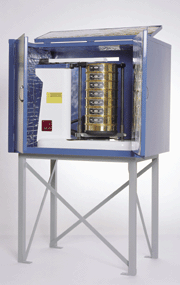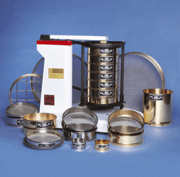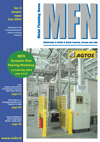E-Archive
Articles
in Vol. 5 - January Issue - Year 2004
Performing a Sieve Analysis

Ro-Tap

Ro-Tap
Since the sieve analysis is a very important part of checking the quality of new or used media for shot peening, MFN asked W.S. Tyler to provide a detailed description. The American company was glad to help out.
One can only begin a particle size distribution analysis after properly collecting, preparing and sizing a sample. The test sieves have to be selected with mesh openings that reveal particle distribution at critical sizes. These are usually stated in a product specification or determined by material processing requirements.
To perform the analysis, the following has to be done:
1. Stack the sieves on top of each other with the coarsest (largest opening) on the top of the stack.
2. Put a bottom pan under the finest (smallest) opening sieve. This pan collects “fine” material that passes through the last one.
3. Use a laboratory scale (accurate to 0.1 gram) to weigh an empty container (such as an extra empty bottom pan) and establish the tare weight.
4. Weigh the sample material.
5. Empty the sample into the top of the stack. Make sure you do not overload the surface as this causes “blinding” or blocking of the openings.
6. Put the stack into the sieve shaker.
7. Place a cover on the top of the stack.
8. Make sure the stack is securely in place.
9. Set the proper length of time to agitate the material.
10. Turn on the shaker and run the test.
11. After the shaker stops, empty the material from the coarsest sieve into the empty container that you weighed in step (3). Use a soft bristle brush to gently brush the underside of the sieve to remove all the particles.
12. Tap the side of the frame with the handle of the brush to clean the remaining material from the sieve.
13. Weigh the contents in the pan to the nearest 1/10 gram and record the data.
14. Return the material to its original sample container.
15. Repeat steps 11 through 14, using the container referenced in step 3, for each sieve, including the fine material in the bottom pan.
16. Add up the weights to make sure the sum of the retained material and the material in the bottom pan is as close as possible to the original weight. Check your specification for allowable variation.
17. Divide the weight obtained from each sieve by the weight of the original sample. Record the percentage for each sieve.
18. Calculate and record the cumulative percentages as required.
The test is now complete. One can use the information for analysis. Most industries set up their specifications by the percent of material retained on a particular sieve. Some industries, however, use the percent passing through a particular sieve for analysis.
For information on the Tyler sieves:
W.S. Tyler, 8570 Tyler Boulevard
Mentor, Ohio, USA
Tel. USA: 800.321 6188
Tel. +1.440.974 1047
E-mail: wstyler@wstyler.com




























